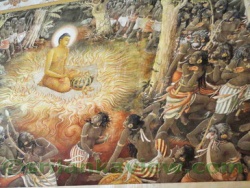The Sarvāstivāda Soteriology and the Mārga Schema by Liew Jew Chong (Venerable Dhammapāla)
1. The Meaning and Significance of ‘Path’ as the Fourth Noble Truth
The fundamental early Buddhist theory of the four Noble Truths emphasized a ‘mārga’ (‘path’ - the fourth Noble Truth) which if diligently adhered to can actualize the putting to an end of suffering third Noble Truth - the truth of suffering is the first Noble Truth) and the causes of its arising (second Noble Truth). In early Buddhism, this was typically identified as the ‘Noble Eightfold Path,’ āryāāgikamārga) which depicts with a high level of generality those aspects of life whose regulation is integral to spiritual progress - rightviews (samyag-i), right thought (samyak-samkalpa), right speech (samyagvāk), right actions (samyak-karmānta), right livelihood (samyag-ājīva), right effort (samyag-vyāyāma), right mindfulness (samyak-smti), and right concentration (samyak-samādhi).
The concept of the ‘path’ as applicable to the fourth noble truth was interpreted by the Sarvāstivādins as emphasizing the entire process of spiritual journey that starts from where most practitioners begin (ie, the level of the ordinary worldling), and ends in the extinguishing of all suffering - the final realization of nirvāna. This understanding is expressed succinctly in the Abhidharmakośa-bhāya (AKB), which describes mārga as ‘the path to nirvāna because it goes from here; or rather, because it is through it that nirvāna is searched out,’1 or the ‘way/route’ [or practice] (pratipad), ‘because, by it, one arrives at nirvāna.’ 2 Other definitions similarly emphasize its relationship with the final goal of spiritual emancipation.3 A multifaceted understanding of the fourth Noble Truth that in particular emphasis its ‘destination’ in ultimate nirvāna is presented in the AKB via interpretations of its four defining ‘modes of activity’ (ākāra) - ‘path’ (mārga ‘道’), ‘truth’ (nyāya ‘如’), ‘way of practice’ (pratipad ‘行’), ‘conducive to exit’ (nairyāika ‘出’):4
1. It is a path (mārga)
a) ‘because one traverses (towards nirvāna)’
b) ‘because it is opposed to the wrong path (mithyāmārga 邪道)’
c) ‘because it resembles the right path (正道)’
d) ‘counteragent to ‘the view that there is no path (無道)’
2. Truth (nyāya)
a) ‘because it is yogayukta (契正理), that is to say, endowed with proofs, endowed with resources or means’
b) ‘because it is opposed to non truth (不如)’
c) ‘because it is true (如實轉)’
d) ‘counteragent to the view ‘that the false path (邪道) [is the Path)’
3. Way [of practice] (pratipad)
a) ‘because it inclines towards nirvāna’
b) ‘because it is not opposed [to leading to] the city of nirvāna (涅槃宮)’
c) ‘because it definitely can go [towards nirvāna)’ - as it is said this path can arrive at purity - other views (餘見) [ie, systems]5 definitely do not arrive at purity.
d) counteragent to the view ‘that there are other paths (餘道)’
4. Conducive to exit (nairyāika)
a) ‘because it enables one to absolutely transcend [[[mundane]] existence)’
b) ‘because it abandons all existence (一切有) [ie, the three realms)’
c) ‘because it leads to absolute separation from existence’
d) ‘counteragent to the view of ‘paths of retrogression (退道)’
Thus according to the Sarvāstivāda, ‘the Path’ (mārga) entailed in the fourth Noble Truth referred to the solitary ‘true/correct’ (nyāya) ‘route’ or ‘way’ (pratipad) capable of leading the practitioner to ‘exit’ from the ‘here’ of the mundane world and traverse to the transcendental ‘city of nirvāa’ (nairyāika). The sense of ‘journey’ imbued in these metaphorical definitions furthermore reflects the perception that the correct path entailed a necessarily arduous and lengthy process. Indeed, for the Sarvāstivāda, the journey along the road to nirvāna inescapably involves an expansive timeframe, and the refinement of a multiplicity of practices and virtues. This perception is captured in a quote from the sūtra-s contained in the Mahāvibhānā-śāstra (MVS):6
There is no śramana or brāhmana, etc., in the past, present or future who can acquire knowledge and vision with regard to all dharma-s abruptly… One must first go through three asamkheya-kalpa-s, practicing tens of thousands of difficult practices, gradually perfecting the six pāramitā-s, in order that one can possess true knowledge and vision with regard to all dharma-s.
2. The Sarvāstivāda Five-Path Schema
The elongated time-span and manifold components attributed to the path in the Sarvāstivāda teachings most likely stemmed in part from the school’s awareness and attempts to organize the vast totality of practices, attainments, ‘paths’ (mārga) and spiritual grades etc. present in the disparate teachings accessible to them. In their attempts to provide a synthesized and complete rendering of these disparate teachings, a schema was devised, based on precedents in the sūtra, through which these varying components were to be organized and ranked via their allocation into a series of distinct and progressive ‘paths,’ or ‘stages’7 which may be transcended sequentially, and which represent the entirety of the process of spiritual progression from the stage of the ordinary beginner to nirvāna. The most fundamental of these in the Sarvāstivāda soteriology is the division between five basic stages which we shall detail below:
- (1). The Path of Requisites (sambhāra-mārga);
- (2). The Path of Preparatory Effort (prayoga-mārga);
- (3). The Path of Seeing (darśana-mārga);
- (4). The Path of Cultivation (bhāvanā-mārga), and;
- (5). The Path of the Non Trainee (aśaik�a-mārga).
2.1. The Path of Requisites (sambhāra-mārga)
The Path of Requisites constitutes the essential first stage of the spiritual career, and involves the basic task of accumulating merits (Skt. punya; Pāli. puñña), which serve as the essential foundation for spiritual progress (ie, ‘requisite’), and the basis through which practitioners can avoid rebirth in the evil realms (ie, where practice is impossible). Its primary practices, essential for the accumulation of merit, are the ‘three meritorious actions’ - giving (dāna), moral observance (śīla), and the cultivation of meditation (bhāvanā). Of particular significance is the cultivation of ‘meditation.’ Through the cultivation of meditation the practitioner is able to purify his mind and accumulate ‘wisdom,’ facilitating the ability to eradicate faults and defilements in both this and the higher stages.
2.2. The Path of Preparatory Effort (prayoga-mārga)
After the preliminary skills for cultivation have been gradually accumulated, a practitioner begins the Path of Preparatory Effort, marked by the cultivation of various kinds of meditative practices – calming meditation (śamatha) and insight meditation (vipaśyanā). Advancement through this path, which has in total seven sub-stages, culminate in an experience which marks the practitioner’s exit from the mundane realm of the ‘ordinary worldling’ - the supramundane insight into the four Noble Truths (darśana-mārga = satya-abhisamaya). The practices and attainments of this stage can be divided into two distinct groups:
(1) The preliminary mok�abhāgīya, marked by the ‘preparatory’ practices of calming meditation (śamatha) and insight meditation (vipaśyanā), which are ‘conducive’ to the later attainment of nirvāna;
(2) The nirvedhabhāgīya, which consists of more advanced stages of meditative attainment: warmed-up (u�magata), summit (mūrdhan), receptivity (k�ānti) and worldly supreme dharma (laukikaagra-dharma) that more directly induce ascension into the realm of the supramundane.
2.3. The Path of Seeing (darśana-mārga)
The Path of Seeing is the location of a process in which ‘direct-comprehension’ (abhisamaya) of the Four Noble Truths is first obtained, marking the birth of transcendental insight. Unlike the other four Paths, its duration is both determined and extremely short - occurring over a process of sixteen uninterrupted moments in which insight into the 16 modes of activity (ākāra-s) pertaining to the Four Noble Truths are sequentially accumulated. A key feature of this path is that its initiation marks the immediate transition between spiritual grades (‘lineage’ - gotra) - one instantly rises from the level of the ordinary worldling (p�thagjana) to become a ‘noble saint’ (ārya), whenceupon cognitive views (d���i) and doubts (vicikitsā) are abandoned completely. Once this stage has been entered the practitioner will without fail secure a rapid ascension into the next stage, and will never again descend to the worldly realm.
2.4. The Path of Cultivation (bhāvanā-mārga)
The Sanskrit term ‘bhāvanā’ is generally translated as ‘meditation.’ However, Prof. KL Dhammajoti states that it is best understood as the ‘cultivation’ or ‘development’ of the mind, which in turn best encapsulates the modes of practice pertaining to the bhāvanā-mārga.8 The naming of this stage as bhāvanā in the sense of ‘cultivation’ in part highlights its contradistinction to The Path of Seeing, whose sole means for the eradication of defilements is instant ‘direct-comprehension’ or ‘insight.’ Upon exiting of the Path of Seeing, certain defilements unable to be extinguished by insight - some of those of the type that are only ‘abandon-able through cultivation,’ (bhāvanā-heya) remain, and are gradually eradicated through repeated practice in the Path of Cultivation. Of these, there are a number that, in certain instances, are also subject to eradication by means of the ‘cultivation’ of the worldly path (laukika-bhāvanā-mārga). Only the ‘supramundane’ Path of Cultivation (lokottara-bhāvanā-mārga), however, can eradicate the subtler categories of defilements of the type ‘abandon-able by cultivation’ (ie, those pertaining to the sphere of neither-ideation-nor-non-ideation (naivasamjñā-nāsamjñāyatana = bhavāgra) whose removal creates the conditions for ascension into the final path - the Path of the Non Trainee.
2.5. The Path of the Non-trainee (aśaik�a-mārga)
The last stage is that in which the saint becomes an arhat - known as the ‘non-trainee’ (aśaik�a) on account of the fact that he has attained the highest spiritual fruit, and thus no longer requires training.9 Its entrance is marked by the development of a ‘diamond-like’ (vajropama) samādhi (meditative concentration), so called in reference to its ability to ‘cut through’ the most resilient and subtle of defilements - those pertaining to the ninth and highest grade. Upon their abandonment, the saint acquires ‘the knowledge of the exhaustion [of outflows]’ (k�ayajñāna), through which he can expel the ‘outflows’ (āsrava) which cause one to ‘flow’ through the realms of samsāric existence - becoming an arhat.10 The highest attainment of this path - only attainable by the ‘immovable’ type of arhat, is ‘the knowledge of the non-arising of outflows,’ (anutpāda-jñāna) by means of which all remnant traces (vāsanā) of defilements and all subtle forms of ‘undefiled’ ignorance (akli��a-ajñāna) are permanently abandoned, ensuring unconditionally and with absolute certainty entrance into nirvān�a.
3. The Fundamental and Distinctive Characteristics of the Sarvāstivāda Path Theory
As highlighted above, the Sarvāstivāda teachings are important for informing our understanding of the articulations of the Path theory in early Indian sectarian Buddhism. However the lack of comparable sources from its contemporaries, in addition to continuing confusion regarding the identity, inter- relationships and origin of different sects, makes the task of identifying what is unique to the Sarvāstivāda, and the extent to which its doctrines are representative of the contemporary sectarian intellectual milieu, an exceedingly difficult one. In this regard we must be grateful for the MVS and *Samayabhedoparacanacakra, whose outlaying of the distinctive views of various sects and authors has provided important resources for identifying, at a preliminary level, the unique, shared and opposing doctrinal theories and positions essential to defining and contextualising the Sarvāstivāda path teachings.11
It may be said that in general, the majority of the practices, attainments, realms, sequences and conceptual tools appearing in the Sarvāstivāda path theory seem to have shared by other sectarian schools, either in view of their collective inheritance of a previously unified order and canon, or as a result of the influence and authority the Sarvāstivāda Abhidharma was able to exert on its contemporaries. This is more apparent when we consider that of the 44 disputed doctrines mentioned by the Sarvāstivādin scholar Samghabhadra as representing the heterodox views of other schools - and thus defining the positions of the Sarvāstivāda, only 3 are related to the path, and of those only one directly so (ie, the belief that defilements can not be abandoned in the worldly path).12 Nonetheless, within the Sarvāstivāda soteriology there are several path-related doctrines or doctrinal positions that are moreso definitively ‘Sarvāstivādin’ - or at least rare amongst its contemporaries. It must also be remembered that within the Sarvāstivāda tradition, there were differences and disputes amongst Ābhidharmika-s, as well as inconsistencies or contradictions in the course of the school’s evolution.
In this section we have provided a preliminary list and summary explanations of the fundamental conceptual tools as well as the definitive, characteristic Sarvāstivāda doctrines essential for framing an informed interpretation of the various individual components and stages of the Sarvāstivādin Path theory. This discussion shall be limited to eight components that the author feels most clearly elucidate the fundamental underlying theoretical processes and mechanisms, as well as highlight the distinctive attributes of the Sarvāstivāda teachings:
- (1). Attainment and the Abandoning of Defilements
- (2). Endowment (samanvāgama) and Acquisition (prāpti)
- (3). Counteragents (pratipakṣa)
- (4). The Unhindered Path (ānantarya-mārga) and the Path of Liberation (vimukti-mārga)
- (5). Defilements ‘Abandon-able by Seeing’ (darśana-heya) and ‘Abandon-able by Cultivation’ (bhāvanā-heya)
- (6). The Path of Seeing and the Division Between the Worldly (laukika) and the Supramundane (lokottara)
- (7). ‘Out-of-sequence’ Attainments
- (8). Retrogression (parihār)i)
3.1. Attainment and the Abandoning of Defilements
The entity commonly known as ‘defilements’ (kleśa) are denoted by many terms in Buddhist discourse, including proclivity (anuśaya), fetter (samyojana), envelopment (paryavasthāna), and outflow (āsrava). In Sarvāstivāda theory they are regarded as the cognitive and emotional entities whose possession (prāpti) by an individual creates undesirable karmic retributions and ignorance, perpetuating the subject’s entrapment in samsāra. In the path teachings of the Sarvāstivāda, it is the abandoning of defilements, rather than the cultivation or development of various virtues or spiritual abilities, that is depicted as the ultimate goal (ie, nirvāna), and the key standard for measuring progress through the various stages. This key relationship is described succinctly by Cox in her article ‘Attainment though Abandonment: The Sarvāstivādin Path of Removing Defilements’:13
- … later Sarvāstivādin Abhidharma texts do not present either the practice of concentration or the acquisition of knowledge as the ultimate religious goal, but rather as means for abandoning and preventing the future arising of defilements… The aspirant progresses along this path by successively abandoning defilements that are associated with an established sequence of cosmic realms and cognitive stages, and by attaining virtuous qualities, powers, paths, or fruits associated with each realm or stage. Similarly, retrogression (parihār)i) from a given level of religious attainment is possible given the reemergence of defilements specific to that level. The final goal of enlightenment (bodhi) is defined as consisting of the two varieties of knowledge of the destruction of the fluxes (āsravakṣayajñāna) and knowledge of their absolute future non-arising (anutpādajñāna).
In the Abhidharma teachings, defilements are categorized with regards to their association with spiritual progress or attainment in two schemas: the first is that of the ‘five categories’ (pañca nikāya), which differentiates four lower categories designated as belonging to the type ‘abandon-able by seeing’ (darśana-heya) that can be extinguished in either the Path of Seeing and, in most instances, the worldly Paths, and a fifth category that is ‘abandon-able by cultivation’, which can only be eradicated upon reaching the fourth stage - the supramundane Path of Cultivation.
The second and most widely applicable schema is that of the ‘81 grades’ that pertain to the fifth category elucidated above. In this schema, nine fundamental grades are differentiated according to their level of subtlety and resilience - starting from the most coarse and easy to remove (strong-strong), to the most subtle and hardest to penetrate (weak-weak). Each of these is further subdivided by the 9 increasingly subtle realms to which each pertains - thus deriving a total of 81. As the practitioner progresses, his spiritual rank essentially corresponds with the number of grades of defilements he has been able to abandon - he is a ‘once-returner’ (sakrdāgāmi) upon having cut six to eight grades of defilements, an no-returner (anāgāmin) who has cut all except the 9th grade defilements pertaining to the highest (9th) realm (bhavāgra) and upon abandoning the 9th grade becomes an arhat.
3.2. Endowment (samanvāgama) and Acquisition (prāpti)
As the Sarvāstivāda holds that ‘all dharma-s exist over the three times’ (ie, past, present and future), the abandonment of a defilement can not be considered to amount to its ‘extinguishing’ or ‘annihilation’ in real terms. Instead, for the Sarvāstivāda, the question of whether or not a practitioner is afflicted by a defilement is a matter of whether or not the practitioner is in ‘possession’ or ‘endowment’ (samanvāgama) of the defilement in question. For the Sarvāstivāda, the mechanics of such ‘possession’ and the process by which a practitioner achieves ‘non-endowment’ (asamanvāgana) with regards to a particular defilement are described by two interrelated concepts - ‘acquisition’ (prāpti) and ‘non- acquisition’ (aprāpti).
‘Acquisition’ is the force neither mental nor material in nature which attaches a particular defilement (or other dharma) to a subject, by virtue of which the subject becomes ‘endowed’ with it. Likewise, in Sarvāstivāda theory a defilement becomes ‘abandoned’ (ie, ‘non-endowed’) when an opposite force is attained - that of its ‘non-acquisition’ (aprāpti). Progress through the path in Sarvāstivāda theory thus essentially equates to the accumulation of the ‘aprāpti’ of various defilements.
3.3. Counteragents
That which brings about the abandonment - or ‘non-acquisition’ of a particular defilement is called a ‘counteragent’ (pratipakṣa). Through the ‘acquisition’ of a counteragent, an opposite force counters the ‘prāpti’ that binds a defilement arises in the subject, bringing about the subject’s ‘non-endowment’ with the affliction. As the word implies, there is an assumed degree of correspondence between the defilement and the dharma that acts as its counteragent, whether in terms of quality (ie, contemplating the deterioration of the body counteracts lust) or strength (discussed below). In Abhidharma theory, as each stage and sub stage of the higher realms corresponds with an increase in the categories of defilements able to be abandoned, so does progression through the path represent an increase in the potency of the spiritual practices acquired. Such practices are in this sense regarded as ‘counteragents’ - which are perhaps best explained as ‘antidotes’ to the grade of defilements they are able to eradicate. These counteragents are also divided into nine grades which directly correspond to the nine fundamental grades of defilements described below. The sequence of abandoning defilements operates according to this principle: the grossest or ‘strong-strong’ grade of defilement is abandoned by the subtlest, or ‘weak-weak’ grade of its counteragent; the ‘strong-medium’ grade of defilement by the ‘weak-medium’ grade of counteragent, and so forth, continuing this negative correlation up to the level of ‘weak-weak’ defilements, which must be abandoned by ‘high-high’ counteragents (ie, pertaining to the Anāgāmin - the stage prior to entry into the Path of the Non-Trainee). In the first case, since the grossest defilement (i.e. ‘strong-strong’) is the easiest to be counteracted, the weakest counteragent
(i.e. ‘weak-weak’) is used. This principle is described in the AKB with the analogy of washing a stained cloth - the grossest stains are purged first, and the subtlest ones the last; and via the analogy of the lighting of a dark room - the grossest darkness is undone by a weak light, whilst the most subtle darkness can only be illuminated by the strongest light.14 With reference to the overall constitution of the spiritual journey, Samghabhadra categorises counteragents into four ascending ‘paths,’ each harboring a specific dominant characteristic.
Based on the overview and translations provided by Prof. KL Dhammajoti, these are summarized below:15
- 1. ‘Counteragent resulting in abandonment’ (prahāna-pratipakṣa) - this path ‘directly abandons the prāpti-s of the defilements. It is called the ‘Unhindered Path’ (ānantarya-mārga).
- 2. ‘Counteragent that effects the maintenance (ādhāra-pratipakṣa) of the abandoning so obtained’
- designates the ‘noble path which first arises together with the prāpti of abandonment. It is called the ‘Path of Liberation’ (vimukti-mārga).
- 3. ‘Counteragent that results in distancing’ (dūrībhāvapratipakṣa) - this path ‘causes the prāpti of
the defilement to be cut, to be more distant’ (chinna-prāpti-dūrīkarar)āt) - which Prof. KL Dhammajoti says equates their being ‘removed.’ It is called the ‘Path of Distinction’ (viśeṣa-mārga).
- 4. ‘Counteragent that finds disgust’ (vidūṣana-pratipakṣa) - represents the stage where the practitioner ‘generates deep disgust’ at ‘the faults in whichever sphere and stage where the counteragent arises.’ This is also called the ‘Preparatory Path (prayoga-mārga). It is notable that this order differs from that proposed by Samghabhadra’s opponent Vasubandhu, who places the ‘Preparatory Path’ first.16 Despite doubts regarding the latter’s sectarian affiliations, his arrangement in some ways more faithfully reflects the Sarvāstivāda path structure, as the ‘Path of Preparatory Effort,’ which precedes the Noble Path, identifies ‘disgust’ at the impurities/sufferings of ones realm as a major impetus for spiritual progress. There is also a more practical logic to Vasubandhu’s order, in that some degree of ‘disgust’ at a defilement is likely to both motivate and precede its effective abandonment.
3.4. The Unhindered Path and the Path of Liberation
The process of the abandonment of defilements is also understood through its division into two components whose names we have just mentioned - (1). An initialising ‘Unhindered Path,’ (ānantaryamārga) denoting a ‘receptivity’ (k�ānti) to the arising of (2). ‘Knowledge,’ (jñāna) attained in the ‘Path of Liberation’ (vimukti-mārga). The division between these is described in the MVS17 as follows: the Unhindered Path is that which specifically ‘cuts’ (斷) the defilement in question, whereas the latter prevents its re-arising (持令不生) - marking the rising of the prāpti of its disconnection (visamyogaprāpti) (ie, its ‘non-acquisition’/aprāpti = ‘non-endowment’/asamanvāgama). These two functions are further described through several similes: one person (‘Unhindered’) pushes a thief out of the house whilst the other (‘Liberation’) closes the door behind him; one person (‘Unhindered’) puts a snake into a jar whilst the other (‘Liberation’) places a lid over it, etc.18
Stemming from the general sense of preparatory ‘receptivity’ (kṣānti) and emancipatory ‘knowledge’ (jñāna), ‘Unhindered Path’ and ‘Path of Liberation’ have several applications in the Sarvāstivāda path theory, being members of a generally descriptive ‘fourfold counteraction’ schema,19 as discussed briefly above, as well as denoting specific mechanisms in the processes of abandoning defilements and spiritual ascension in the worldly path. In the Supramundane Path, these two, also in association with the senses ‘receptivity’ and ‘knowledge,’ are further related to the twin stages of ‘candidacy’ for a spiritual rank and its ‘fruition’ - denoting the stage immediately prior to, and that marking the actual ‘fruition’ or realization of a spiritual grade respectively (ie, ‘arhathood’).
3.5. Defilements ‘Abandon-able by Seeing’ and ‘Abandon-able by Cultivation’
Defilements can also be classified as belonging to two categories: those ‘abandon-able by seeing’ (darśana-prahātavya/ darśana-heya) - referring to those abandoned by means of direct comprehension into the four noble truths during the Path of Seeing, and those ‘abandon-able by cultivation’ (bhāvanā- prahātavya/ bhāvanā-heya) - abandoned via the practices of the worldly paths, or the supramundane Path of Cultivation.
Although the terms darśana-prahātavya and bhāvanā-prahātavya existed in the Sūtra-s, the Sarvāstivāda school introduced what Frauwallner identified as a ‘new’ theory, ‘abhisamayavāda,’20 which presented these two in a dichotomy - emphasizing greatly the role of abhisamaya (direct comprehension), and attached more precise and technical meanings to these two terms. In this theory ‘10 anuśaya-s are attached to a human being and these are divided into 98 subtypes according to how they are eliminated and the sphere to which they belong.’21 Of these, 88 (at most) are abandoned instantaneously by ‘a single process of cognition [ie, direct comprehension) which consists of a beholding of the 4 Noble Truths and is divided into 16 moments’ - designated as darśanaprahātavya- anuśaya-s. However, a number of defilements - the most resilient of those that are of an affective nature known as ‘passions’ (greed (rāga), hostility (pratigha), pride (māna), ignorance (avidyā)) are unable to be eradicated via this process, and can only later be ‘eliminated by the repeated realization of the knowledge gained [from direct comprehension of the four truths)’22 - known as bhāvanā- prahātavya-anuśaya-s, which pertains to the Path of Cultivation. Overall this type has 10 constituents, making for a total of 98.
A distinctive feature of the Sarvāstivāda is the differentiation between these two terms and those of a similar dichotomy - that between defilements ‘foremost [abandon-able by] seeing’ (見為前行) and ‘foremost [abandon-able by] cultivation’ (修為前行).23 In other schools, which recognize only the first dichotomy, ‘views’ and ‘doubt’ - the ‘cognitive’ defilements are exclusively ‘abandon-able by seeing,’ whilst only those of an ‘affective’ nature can be abandoned by ‘cultivation,’ confined, in the main, to the supramundane ‘Path of Cultivation.’ For the Sarvāstivādins, however, both the Path of Cultivation and Path of Seeing are able to abandon, through ‘cultivation’ and ‘seeing’ respectively, each of the two categories. This theoretical development in turn related to the Sarvāstivādin position, in opposition to that of other schools, that the ordinary worldling is capable of abandoning defilements through cultivation (extending up to those pertaining to the ākimcanyāyatana).
3.6. The Path of Seeing and the Division Between the Worldly and the Supramundane
The Path of Seeing is a crucial moment in the Sarvāstivāda path theory, marking the first instance of direct comprehension (abhisamaya) into the four noble truths - the exclusive counteragent for a number of defilements, and the key transition of the practitioner from the ‘worldly realm,’ to the transcendental realm of the noble saints (ārya). Having attained the Path of Seeing, the practitioner is equipped to abandon all remaining subtle defilements, paving the way for entrance into arhat-hood. The practitioner is hereupon destined to reach enlightenment, and shall never again return to the realm of the ordinary worldling until reaching final nirvār)a. The significance of the Path of Seeing with regard to its role in the division between the Worldly and Supramundane Paths in Sarvāstivāda thought was, according to Frauwallner, greatly enhanced by what he identifies as ‘abhisamayavāda’ 24 - which we may translate as ‘the theory of ‘abhisamaya.’’ According to this theory, in addition to its own role in eliminating 88 types of defilements, the efficacy of meditative practices to abandon defilements in the Path of Cultivation (ie, post-abhisamaya) owes itself to the very insights gained through the Path of Seeing. In addition, the fruition of the ‘apparent’ abandonment of defilements which can occur by means of cultivation in the worldly path is not actually realized until the Path of Seeing (where the abandonment is permanent and absolute), resulting in progress that is ‘out of sequence.’
3.7. ‘Out-of-sequence’ Attainments
The position that the ordinary worldling can abandon defilements up to the stage of the existence peak (bhavāgra) is the basis of another distinctive Sarvāstivāda theory - that which Prof. KL Dhammajoti calls ‘out-of-sequence attainment.’25 This theory holds that on the basis of the abandonment of defilements achieved by a diligent practitioner prior to his ascension to the supramundane, he may enter the Path of Seeing as a ‘Candidate’ (pratipannaka) of a higher fruit in the Path of Cultivation, and thus be capable of ‘skipping’ the lower fruits upon exiting the Path of Seeing. The fruition achieved upon this ‘skipping’ is determined in turn by the number of categories of defilements abandoned before entry into the Path of Seeing, extending to a grade of the highest fruition of the Path of Cultivation that immediately precedes Candidature for Arhat-hood – the Non-returner (Anāgāmin).
3.8. Retrogression
‘Retrogression’ (parihār)i) refers to the liability inherent in a stage (ie, path), sub-stage, or person pertaining to a certain ‘faculty’ (indriya) for spiritual retrogression to either an earlier level within that stage, or a previous path(s). Such a process is furthermore differentiated amongst the five stages, including discrepancies in the lowest destination of retrogression applicable at each stage, and in some instances the causes or environmental factors determining retrogression. Despite the potential destinations of retrogression being varied, there are two general limitations governing retrogression in Sarvāstivāda theory and that are shared with many other Abhidharma schools:
- (1). Retrogression is impossible in the stage which marks entry into the realm of the supramundane - the Path of Seeing; and
- (2). Once a practitioner has entered the supramundane, he is in a sense ‘safe’ from the more serious repercussions of any subsequent retrogression, as he can never return to the stage of an ordinary worldling (ie, the Path of Requisites and the Path of Preparatory Effort) A distinctive and controversial doctrine of the Sarvāstivāda is that even some arhat-s - of the type marked by the predominance of certain ‘inferior’ faculties (indriya), are under certain circumstances also liable to a limited degree of spiritual retrogression. In this teaching, only one of a total of 6 types of arhat-s is not liable to retrogression under any circumstances - known as the ‘immovable’ type (akopyadharman), and whom is endowed with the highest faculty.
NOTES
1 AKB, 382: kasmāt mārga ityucyate / e�a hi nirvā�asya panthā tena tadgamanāt / nirvā�am margayantyaneneti vā. Trans: Why the ‘path’ is spoken of? For this is the path way to nirvā�a because of the going to that [nirvā�a] by means of that [[[path]]); or through this, they [practitioners] seek nirvā�a.
2 AKB, 382: mārga eva puna� pratipadityukto nirvā�apratipādanāt / Trans: The very path furthermore is spoken of as the course (pratipad), because of [its] leading to nirvā�a.
3 Ibid, 382.
4 AKB (X), 137a-c.
5 See AKB (Tr), Vol. III, 1115. Poussin translates ‘餘見’ as ‘other systems’.
6 Dhammajoti, KL. Sarvāstivāda Abhidharma, 565.
7 Cox Collett, Disputed Dharmas – Early Buddhist Theories of Existence – An Annotated Translation of the Section on Factors Dissociated from Thought from Samghabhadra’s Nyāyānusāra, (Tokyo, 1995),63-64.
8 Dhammajoti, KL. Sarvāstivāda Abhidharma, 598.
9 AKB, 365: utpanne ca puna� k�ayajñāne so’rhattvapratipannaka� aśaik�o bhavaty arhamścārhattvaphalaprāpta� / phalāntaram prati puna� śik�itavyābhāvādaśaik�a� /
10 Cf MVS, 322a: 離彼第九品結金剛喻定滅。初盡智生時。彼所得斷。名斷名離名滅名諦名遍知。謂 一切結盡遍知名沙門果。謂阿羅漢果。
11 Cox. Collett., ‘Attainment through Abandonment: the Sarvāstivādin Path of Removing Defilements’ Paths to Liberation ¯� The Mārga and its Transformation in Buddhist Thought, (Delhi: Motilal Banarsidass, 1992): 63-8
12 Dhammajoti, KL. Sarvāstivāda Abhidharma, 65-67.
13 Cox. Collett.‘Attainment through Abandonment: the Sarvāstivādin Path of Removing Defilements’ in Paths to Liberation ¯� The Mārga and its Transformation in Buddhist Thought, (Delhi: Motilal Banarsidass, 1992): 76-77.
14 AKB, 355.
15 Dhammajoti, KL. Sarvāstivāda Abhidharma, 460-461
16 AKB, 320: api tv e�ām iyam ānupurvī sādhvī bhavet … /
17 MVS, 333c.
18 Ibid, 334a.
19 Dhammajoti, KL. Sarvāstivāda Abhidharma, 460-1.
20 See Frauwallner, ‘The Abhisamayavāda’ in E. Studies in Abhidharma Literature and the Origins of Buddhist Philosophical Systems, Eng. Tr. by Sophie Francis Kidd, (Albany: State University of New York Press, 1995), 149-184.
21 Ibid, 154.
22 See Frauwallner, ‘The Abhisamayavāda’ in E. Studies in Abhidharma Literature and the Origins of Buddhist Philosophical Systems, Eng. Tr. by Sophie Francis Kidd, (Albany: State University of New York Press, 1995),158
23 MVS, 265a-266c.
24 See Frauwallner, ‘The Abhisamayavāda’ in E. Studies in Abhidharma Literature and the Origins of Buddhist Philosophical Systems, Eng. Tr. by Sophie Francis Kidd, (Albany: State University of New York Press, 1995), 149-184.
25 Dhammajoti, KL. Sarvāstivāda Abhidharma, 602-3.
Source
Author: Liew Jew Chong (Venerable Dhammapāla)
buddhismandaustralia.com







